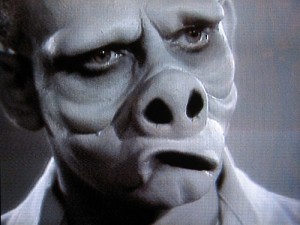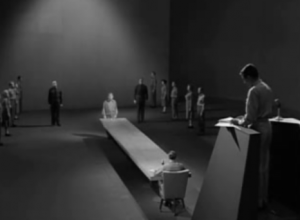 The Twilight Zone is one of the classic examples of fantasy, thriller, science fiction television, with a legacy that continues into the present day. Next month will see the release of The Twilight Zone season 1 & season 2 on Blu-ray DVD. In order to celebrate this event, TheoFantastique will explore The Twilight Zone in several installments by guest writer Arlen Schumer. Schumer wrote and designed Visions From The Twilight Zone, the only coffee table art book about the series, and continues to present a multimedia show based on the book to universities and cultural institutions around the country, including The 2008 Rod Serling Conference at Ithaca University, and the 2009 New York Comic Convention, where he also presented his mini-marathon, “The Five Themes of The Twilight Zone.” He presented his new show, “The Twilight Zone Forever,” at The New York Times’ TimesCenter in New York on the exact 50th Anniversary of The Twilight Zone’s debut, October 2, 2009. On November 11 Schumer will make a presentation in connection with a screening the 50th anniversary of “The Eye of the Beholder” episode at the prestigious Tribeca Cinema. Tickets can be purchased here.
The Twilight Zone is one of the classic examples of fantasy, thriller, science fiction television, with a legacy that continues into the present day. Next month will see the release of The Twilight Zone season 1 & season 2 on Blu-ray DVD. In order to celebrate this event, TheoFantastique will explore The Twilight Zone in several installments by guest writer Arlen Schumer. Schumer wrote and designed Visions From The Twilight Zone, the only coffee table art book about the series, and continues to present a multimedia show based on the book to universities and cultural institutions around the country, including The 2008 Rod Serling Conference at Ithaca University, and the 2009 New York Comic Convention, where he also presented his mini-marathon, “The Five Themes of The Twilight Zone.” He presented his new show, “The Twilight Zone Forever,” at The New York Times’ TimesCenter in New York on the exact 50th Anniversary of The Twilight Zone’s debut, October 2, 2009. On November 11 Schumer will make a presentation in connection with a screening the 50th anniversary of “The Eye of the Beholder” episode at the prestigious Tribeca Cinema. Tickets can be purchased here.
And now, TheoFantastique is pleased to present the first installment by Arlen Schumer:
At 10:00 pm on Friday, October 2, 1959, CBS Television broadcast the pilot episode of a new series, The Twilight Zone. The copy in CBS’ newspaper ad for the debut episode “Where Is Everybody?” enigmatically declared, next to an extreme closeup of, atypically, not the episode’s star, but instead, for the first (and only?) time in the young medium’s history, its writer/creator (“one of television’s most famous playwrights”), Twilight Zone was “…defined by the author as: ‘The land that lies between science and superstition, between the pit of man’s fears and the summit of his knowledge. You will find the bizarre, but the believable; the different, the shocking that is yet understandable.’”
A fine definition, to this day, of good science-fiction literature—but the ad’s next line can be read indirectly as a pre-post-modern justification of television itself as being on par with any literary genre or visual narrative, like film—while superseding the medium that preceded TV, radio: “Its tales must be shown; they cannot be told.”
The ad concludes, “And each carries with it its own special surprise,” a foreshadowing of the O. Henry-esque twist endings that are among The Twilight Zone’s most memorable trademarks—along with its eerie, eternal theme music (French composer Marius Constant), and the sound and vision of the series’ only true star (outshining a who’s-who of Hollywood actors), its multiple-Emmy Award-winning creator, head writer, on-air host and narrator, possessed with perhaps the most singular, dramatic broadcast voice of the 20th Century, Rod Serling (1924-1975).
 Serling firmly places in the 20th Century post-war pantheon of great American-Jewish humanist liberal writers—Arthur Miller, Budd Schulberg, Mad magazine’s Harvey Kurtzman, Bob (Zimmerman) Dylan, Marvel Comics’ Stan Lee (nee Stanley Lieber)—who, though they toiled in commercial entertainment mediums from Broadway to Hollywood, nevertheless produced great and lasting art that has transcended its genre entertainment origins.
Serling firmly places in the 20th Century post-war pantheon of great American-Jewish humanist liberal writers—Arthur Miller, Budd Schulberg, Mad magazine’s Harvey Kurtzman, Bob (Zimmerman) Dylan, Marvel Comics’ Stan Lee (nee Stanley Lieber)—who, though they toiled in commercial entertainment mediums from Broadway to Hollywood, nevertheless produced great and lasting art that has transcended its genre entertainment origins.
Like Serling’s timeless The Twilight Zone, which Image Entertainment is releasing on Blu-ray DVD this fall: Season 1, a startling quantity of 36 original half-hours of anthology drama of unparalleled quality, depth and breadth in the history of television, comes out on September 14th; Season 2, by default the second-best season—but with its own share of classics—follows on November 16th.
Although it shared conceptual concerns with—and adapted stories from—the cream of the science-fiction field, featuring original scripts by science fiction luminaries like Richard Matheson, Charles Beaumont and George Clayton Johnson, The Twilight Zone cannot be wholly considered a science fiction television series.
It wasn’t horror, either—yet many episodes, and their shock endings, are among the most horrific ever filmed for television (or film). And it would be unfair to pass the series off as pure fantasy, for it was grounded in a reality far more real and true for its day—and ours. Yet, in a televised interview with CBS’ own Mike Wallace ten days before The Twilight Zone debuted (included in the raft of DVD extras), Wallace opened with a whopper of a backhanded compliment: “Now that you’re doing The Twilight Zone,” he addressed Serling, “does that mean you won’t be writing anything important for television?”
Wallace was referring to Serling’s pre-Twilight Zone career as the Golden Boy of television’s mid-Fifties “Golden Age,” hour-and-a-half anthology dramas emanating from New York City that made Serling’s bones (three Emmy Awards three years in a row, for “Patterns,” “Requiem for a Heavyweight” and “The Comedian”) but also broke them—his repeated struggles with the TV censors and its de facto censors, the advertising agencies and their corporate sponsors, ironically gave birth to The Twilight Zone itself, half-hour havens safer for the politically- and socially-conscious Serling to ply his morality teleplays than the 90-minute millstones that had already become obsolete by the end of the decade; like the Brooklyn Dodgers and New York Giants, live TV uprooted and moved to Los Angeles, downsizing to cheaper filmed series that could be rerun in perpetuity—modern television as we know it.
Rather than be caught slumming in the new, déclassé format, Serling’s “television playwright” peers, like Paddy Chayefsky (“Marty”) and Reginald Rose (“Twelve Angry Men”), moved “up” to movies, but Serling chose to remain in filmed TV, in The Twilight Zone, much to the feigned chagrin of middlebrow critics like Wallace crying crocodile tears over the loss of live, pseudo-prestigious productions like Playhouse 90.
Serling’s measured, thoughtful response to Wallace’s (in-?) direct insult reveals Rod Serling to be not just a thinking man’s writer, but a true visionary, a pre-pop artist and avatar of the explosion in commercial creativity—modern American popular culture as we know it— that remains the dominant artistic legacy of The Sixties:
“The exciting thing about our medium is its potential, the fact that it doesn’t have to be imitative. What it can produce in terms of novelty and ingenuity has barely been scratched. We want to prove that television, even in its half-hour form, can be both commercial and worthwhile. This is a medium that can spread out, delve deep, probe fully and reach out experimentally to whole new concepts. The horizons of what it can do and where it can go stretch out beyond vision.”
Serling’s vision, The Twilight Zone, would go beyond making Wallace and his ilk eat their words; it became not only one of the most revered and remembered television shows of all time, but a conceptual catchphrase that would enter the lexicon, a touchstone that would profoundly influence a wide spectrum of American artists, actors, writers and filmmakers—today’s science- fiction, fantasy and horror genre creators, from Steven Spielberg to Stephen King (and all their contemporaries and descendants)—all of whom owe a debt to Serling and his dark masterpiece The Twilight Zone for lighting the imaginative sparks that ignited their greatest works.
Indeed, Serling’s surrealistic concept of alternate realities—the “what if…?” quality of The Twilight Zone—paved the way for, and influenced the turbulent 1960s to come, by implicitly (and often explicitly) stating that things don’t have to be the way they are, that authority and the status quo must always be challenged and questioned—and bettered. “A whole generation is able to associate the Serling program with the budding of The Sixties,” acknowledged prolific horrormeister King in Danse Macabre, his idiosyncratic 1981 non-fiction survey of the science fiction, fantasy and horror fields. “At least, as The Sixties are remembered.”
George Clayton Johnson agrees: “The Twilight Zone played just as much a part in the renaissance transformation of The Sixties as bright-colored clothing, rock music and marijuana did. It helped to jack people up to a higher level.”
 A lot of those people were children, according to Buck Houghton, Twilight Zone’s original producer (1959-62). “The appeal to children was a complete surprise to us,” he recalled to Marc Scott Zicree, author of The Twilight Zone Companion in 1981. “We got a lot of nasty notes from parents saying, ‘You’re keeping the kids up.’”
A lot of those people were children, according to Buck Houghton, Twilight Zone’s original producer (1959-62). “The appeal to children was a complete surprise to us,” he recalled to Marc Scott Zicree, author of The Twilight Zone Companion in 1981. “We got a lot of nasty notes from parents saying, ‘You’re keeping the kids up.’”
Chances are, if you were ten years old in 1960, and staying up to watch The Twilight Zone’s episodes about racism (“Eye of The Beholder”), prejudice (“The Monsters are Due on Maple Street”) and nuclear war (“Third from the Sun”), then eight years later you were probably marching against the Vietnam War, taking part in social change, countering the culture and the status quo—just as The Twilight Zone itself countered the status quo of the network television programming of its time, which then-FCC Chairman Newton Minow infamously described in 1961 as a “vast wasteland” of wall-to-wall westerns, cookie-cutter cop shows and bland family sitcoms.
Episodes like Season 2’s final episode, “The Obsolete Man,” filmed on an outsized German expressionist set, must have seemed like broadcasts beamed from alien planets compared to the void of white bread programming surrounding them.
“Here, for once, was something Completely New and Different,” wrote King of The Twilight Zone in Danse Macabre, and of Serling, “who finally answered H.P. Lovecraft, who showed a new direction. For me and those of my generation, the answer was like a thunderclap of revelation, opening a million entrancing possibilities.”
Those possibilities include the productions of not only the most obvious TV knockoffs The Outer Limits (1963), Serling’s own Night Gallery (1969), George Romero’s Tales From The Darkside (1983) and two titular syndicated TV revamps of recent vintage (both in wrong-headed full color and utterly dismissible)—or the Spielberg-produced turkey The Twilight Zone: The Movie (1983)—but practically every example of modern science fiction, fantasy or horror that can trace its roots back to Serling and The Twilight Zone in less than six degrees of separation.
Next Monday, October 18, we will post the second installment that begins with a consideration of the impact of The Twilight Zone on subsequent science fiction, fantasy and horror.





5 Responses to “THE TWILIGHT ZONE FOREVER: On the release of Rod Serling’s The Twilight Zone Seasons 1 & 2 on Blu-ray (Part 1)”